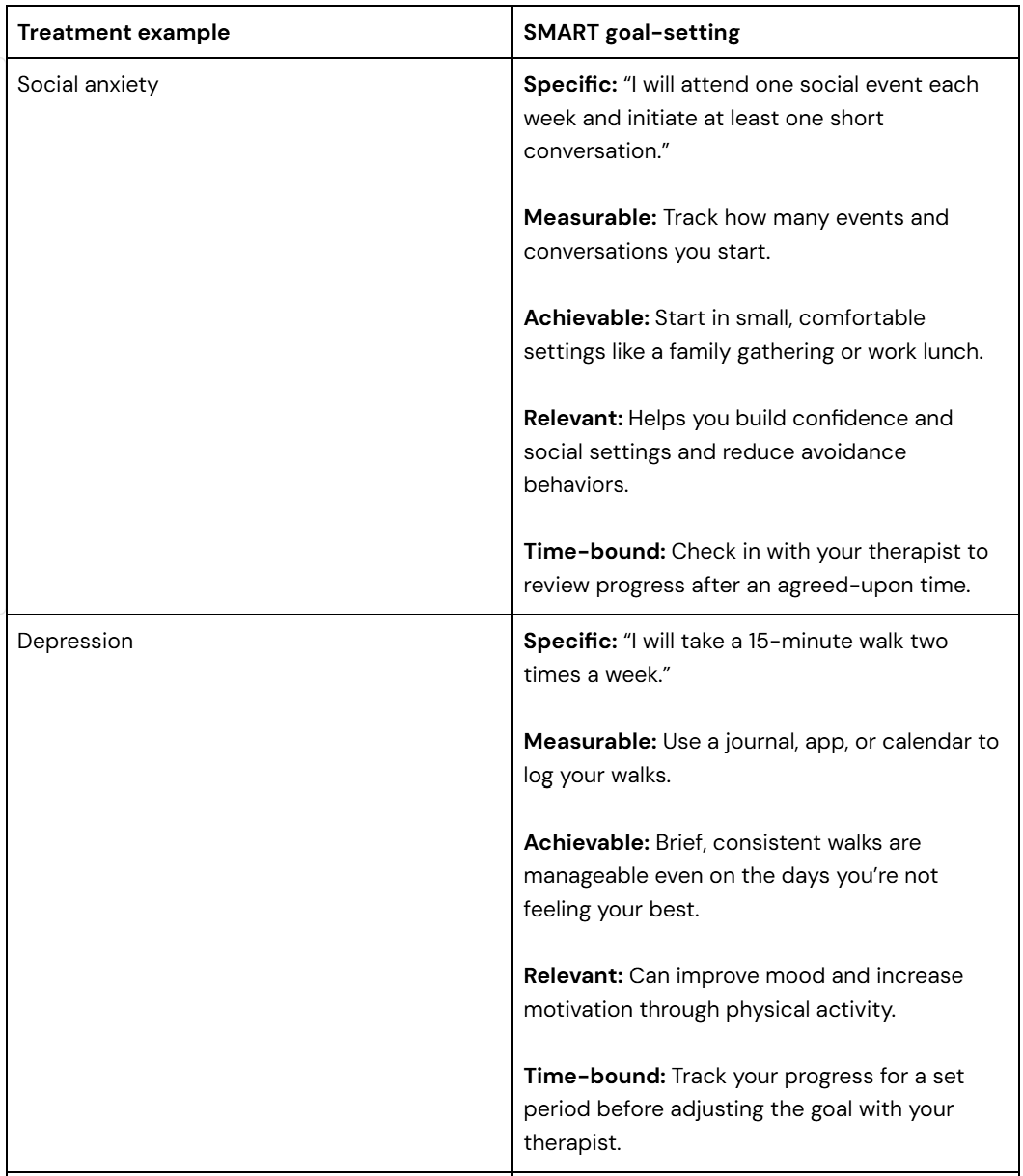
“SMART goals” is an acronym for goals that are specific, measurable, achievable, relevant, and time-bound. This structured approach to goal-setting helps you create clear, actionable objectives within a defined time frame, making your progress easier to track and your goals more attainable.
SMART goals apply to all aspects of your life, but they’re especially beneficial in supporting your mental health. For example, setting specific goals improves the effectiveness of cognitive behavioral therapy (CBT) — a common treatment for anxiety and depression — by 75%.
Goal-setting is an effective way to support your mental well-being throughout therapy and outside of sessions.
Key takeaways
- SMART goals are an evidence–based framework that can help you set clear, actionable objectives in therapy to make lasting and meaningful change.
- Collaborating with your therapist and tracking progress can ensure you stay on track with both your short- and long-term goals.
- Implementing SMART goals in your treatment plan can boost motivation, empowerment, and confidence in your mental health journey.
Understanding SMART goals in therapy
SMART goals are an objective framework that allows you to set practical goals you can stick to. SMART goals are often associated with developing a business plan, but they can be just as beneficial for personal improvement, particularly in taking care of your mental well-being.
In therapy, SMART objectives can help you set effective and achievable therapeutic goals that lead to meaningful, lasting change. You and your therapist can identify what changes you’d like to make, and create a roadmap to get there.
Why SMART goals work
Setting goals is pretty easy, but actually following through with them can be tough. What makes SMART goals more effective is that they break up a big goal into smaller, more digestible parts, which is a major benefit for therapy.
Several studies support the use of SMART goals in therapy:
- In psychology, SMART goals can be an effective way to make health behavior changes.
- SMART goals can improve the CBT’s effectiveness.
- Having clear, structured treatment goals leads to a collaborative and trusting relationship between therapists and patients.
- SMART objectives involve continuous progress monitoring, which improves therapy outcomes by up to 70%.
Breaking down the SMART criteria
SMART objectives therapy is split into five major components. Here’s a look at what each aspect of this goal-setting framework entails:
Specific
The first step in developing a SMART goals-focused therapy action plan is to create a detailed objective. Think of this component as the mission statement of your overall therapy goal.
Your goal should answer the following questions:
- Why do you want to accomplish this goal?
- Who should be involved in accomplishing this goal?
- How will you achieve this goal in therapy?
- When do you plan to complete this goal?
- What obstacles do you have to overcome to achieve this goal?
An example might be “I want to reduce my anxiety by practicing five minutes of deep breathing exercises every morning.”
Measurable
Once you’ve answered the “who, what, why, when, and how,” you’ll now need to start thinking about therapy outcome measures. Monitoring your progress can help you identify trends and make goal adjustments if needed. You and your therapist can collaborate to decide what measurable therapy goals make sense for you.
Let’s go back to that example about reducing anxiety. You might track your progress by logging your mindfulness sessions and anxiety levels in an app or journal each day.
Achievable
When setting goals in therapy, it’s natural to want to think big. But you want to ensure goals feel attainable. For example, “I want to stop feeling anxious completely” is too broad and somewhat unrealistic—everyone experiences anxiety now and then. A more attainable goal would be “I will practice a 10-minute guided breathing exercise three times a week for a month to manage my anxiety symptoms.” This goal has a clear action, fits into a reasonable timeline, and is trackable.
There are three things you’ll want to think about when setting an achievable SMART goal:
- How you’ll reach your goal
- If you need any support, skills, or tools
- If any hurdles could impact your progress
If you’re working to reduce anxiety, you might practice five minutes of deep breathing each morning for the next four weeks. You could set your alarm 10 minutes earlier to make time for it.
Relevant
As you create SMART treatment objectives, you want to ensure your goal has relevance. Do the milestones align with your values and desired therapy outcomes? How does this goal add to your life? Remember that your goal should feel relevant to you. If you’re not feeling connected to it, work with your therapist to reframe it.
A relevant SMART goal would be doing deep breathing exercises every morning to feel calmer and more focused.
Time-bound
The last component of SMART criteria for senior therapy is to create a reasonable and clear timeframe. This goes hand-in-hand with attainability, as you want the timeline to be realistic, but not too soon or far out. There are no hard deadlines in therapy, but giving yourself a specific period to apply skills can be helpful. You can work with your clinician to figure out therapy progress tracking for your goals.
Let’s say you spend four weeks doing deep breathing exercises in the morning to reduce anxiety. After that timeframe, you can review your progress with your therapist and make adjustments if necessary.
Step-by-step guide to setting SMART goals
Client-centered goals are a crucial part of therapy, and SMART goals are standard tools that can help you achieve them.
Below is a step-by-step guide to help you set SMART goals to improve your senior mental health:
- Collaborate with your therapist: Share your challenges, priorities, and what you’d like to achieve in therapy. You can also ask for guidance on breaking larger goals into more manageable and actionable steps.
- Use goal-setting worksheets: Fill out SMART therapy worksheets to thoroughly define each component: specific, measurable, achievable, relevant, and time-bound. You can use apps, calendars, or journals recommended by your therapist.
- Plan your SMART goals in detail: Identify concrete actions for your goals and utilize therapy milestone tracking to measure progress. Prepare for potential challenges or barriers and have plans in place to address them.
- Celebrate successes: Don’t forget to celebrate the small wins, as doing so can help you stay motivated.
Examples of SMART goals in therapy
Here are some treatment goals examples that can apply to CBT, dialectical behavioral therapy (DBT), and other forms of therapy:

Collaborating with your therapist
Therapy collaboration is crucial for establishing CBT goal-setting. A research article written by Georgiana Tyron and Greta Winograd in Psychotherapy states that better treatment outcomes come from you and your therapist agreeing on therapeutic goals and the strategies to achieve them.
If you want to set practical SMART goals, try these tips to get the most out of the process:
- Ask and answer open-ended questions: Rather than sticking to simple yes-or-no responses, try to engage in deeper reflection. Open-ended questions can help you be more expressive and aware of your emotions.
- Be open to motivational interviewing: Motivational interviewing is a therapeutic approach that helps you explore the reasons why you want to change. Reflect on your motivation, whether it’s reducing anxiety, improving relationships, or building confidence. Identifying your “why” can make your goals more personal and achievable.
- Practice shared-decision-making: Look at goal-setting as a partnership. Explore the different options with your therapist, weigh the pros and cons, and agree on what steps are within your comfort zone and needs. This collaborative relationship helps you stay invested in your therapy, which can lead to better outcomes.
- Have regular check-ins about your progress: Your therapy sessions are an opportunity to review what’s working, what needs to change, and how your goals can evolve. Making adjustments can keep you on track and ensure your goals stay realistic.
Monitoring and adjusting goals
Setting treatment goals is just the first step. You also need to track your progress to help you stay accountable and recognize how far you’ve come.
The following strategies can help you and your therapist monitor and reframe your goals over time:
- Use progress-tracking tools: Use an app, journal, or spreadsheet to log moods, actions, or behaviors related to your therapy goals. You can take it up a notch by using habit trackers or mood charts to get a better visual of any patterns.
- Incorporate outcome measures: Your therapist may use standardized tools like the PHQ-9 (depression) or GAD-7 (anxiety) to assess changes over time.
- Use diary cards or daily logs: With treatment approaches like DBT, you can use a diary card or log to record your emotions, actions, urges, and coping skills.
- Schedule regular goal check-ins: Set aside time during sessions to review your progress with your therapist. You can discuss your wins and talk through obstacles you’ve faced. These regular check-ins can help you stay engaged and aligned with your goals.
- Be flexible and adapt: Your goals will likely evolve. You might start with short-term goals that build long-term goals. Recognizing the difference between long-term vs. short-term goals helps you track progress and stay focused on both the small steps and the bigger picture.
Tools and resources
Using journaling for therapy is a popular go-to for many people. However, there are tons of other tools and resources for tracking goals, too. Here are a few that can help you log your progress:
- SMART goal worksheets: These therapy goal templates — which you can print or fill out electronically – provide an easy way to plan out your SMART goals.
- Journaling apps: If you enjoy journaling, you can take it to the next level by using apps like Daylio, Mood Panda, or Journey to write about your progress.
- DBT diary cards: Printable and downloadable diary cards can help with progress tracking of your mood, behaviors, and skills.
Common pitfalls and how to overcome them
Even the most structured, well-intentioned goals can hit roadblocks, and that’s okay. Identifying these pitfalls and knowing how to handle them can help you stay motivated.
- Setting overly rigid goals: If your goals seem a bit too strict or unrealistic, they can lead to a lot of pressure and frustration. It’s best to keep your goals flexible and adjustable and use them as a guide — not a strict rule.
- Feeling like you’re not progressing fast enough: There’s no one-size-fits-all approach to achieving your goals. Rather than focusing on perfection, celebrate the small wins and remind yourself that progress includes setbacks and learning opportunities.
- Losing motivation or clarity: It’s normal to feel like your goals are no longer relevant or don’t align with your current needs. When this happens, go back to the “why” behind your goals. Talk with your therapist about what’s changed and what you value. Making adjustments can reignite your motivation and make your goals feel meaningful again.
How Sailor Health can help
SMART goals for therapy offer a research-backed framework to help you make lasting changes. They give you the structure to help you track progress, stay motivated, and celebrate small wins. SMART goals can also help you feel more empowered in your healing journey.
If you’re an older adult facing mental health struggles and seeking a therapist, Sailor Health can help. We offer teletherapy via computer, phone, or even landline. If you’re a Medicare recipient, you could pay as low as $0 per session. We’re here to give seniors and their families peace of mind that they are in experienced, reliable hands. Get started today.
References
- David, D., Cristea, I., & Hofmann, S. G. (2018). Why cognitive behavioral therapy is the current gold standard of psychotherapy. Frontiers in Psychiatry, 9. https://doi.org/10.3389/fpsyt.2018.00004
- Bailey, R. R. (2017). Goal setting and action planning for health behavior change. American Journal of Lifestyle Medicine, 13(6), 615–618. https://doi.org/10.1177/1559827617729634
- Geurtzen, N., Keijsers, G. P., Karremans, J. C., Tiemens, B. G., & Hutschemaekers, G. J. (2020). Patients’ perceived lack of goal clarity in psychological treatments: Scale development and negative correlates. Clinical Psychology & Psychotherapy, 27(6), 915–924. https://doi.org/10.1002/cpp.2479
- Hyer, L. (2005). Depression in Long-Term Care. Clinical Psychology Science and Practice, 12(3), 280–299. https://doi.org/10.1093/clipsy/bpi031
- Tryon, G. S., & Winograd, G. (2011). Goal consensus and collaboration. Psychotherapy, 48(1), 50–57. https://doi.org/10.1037/a0022061
- Williams, E. N. (2023). The use of questions in psychotherapy: A review of research on immediate outcomes. Psychotherapy, 60(3), 246–254. https://doi.org/10.1037/pst0000471
- Slade, M. (2017). Implementing shared decision making in routine mental health care. World Psychiatry, 16(2), 146–153. https://doi.org/10.1002/wps.20412
- Pfizer Inc. (2005). PATIENT HEALTH QUESTIONNAIRE (PHQ-9). https://integrationacademy.ahrq.gov/sites/default/files/2020-07/PHQ-9.pdf
- Spitzer, R. L., Williams, J. B. W., Kroenke, K., & Pfizer Inc. (1999). GAD-7 anxiety. In Primary Care Evaluation of Mental Disorders Patient Health Questionnaire (PRIME-MD-PHQ). Pfizer Inc. https://adaa.org/sites/default/files/GAD-7_Anxiety-updated_0.pdf
- UNIVERSITY OF WASHINGTON. (n.d.). How to complete the diary Card: Instructions for therapists and clients. https://depts.washington.edu/uwbrtc/wp-content/uploads/NIMH4-S-DBT-Diary-Cards-with-Instructions.pdf
Frequently Asked Questions
What is Sailor Health?

Sailor Health is a premium mental health service designed specifically for older adults. We connect seniors with licensed therapists who specialize in geriatric care, offering personalized therapy to address issues like anxiety, depression, and the challenges of aging.
Our services are accessible through secure online or phone-based sessions, making it easy for you to receive care from the comfort of their homes.
Is Sailor Health covered by insurance?

Yes, Sailor Health is in-network with Medicare and many Medicare Advantage plans, making our services accessible and affordable for our clients. We believe that mental health care should be within reach for everyone, so we work hard to ensure that our services are affordable but exceptional.
What if my loved one isn’t comfortable with technology?

We understand that technology can be intimidating for some older adults. Studies show that many older adults actually find online therapy more comfortable and convenient once they try it, with clinical outcomes comparable to in-person therapy.
Seniors can join therapy sessions with a simple video link or a phone call (no smart phone required). We offer step-by-step guidance and are available to help with any technical issues, ensuring that technology doesn’t stand in the way of receiving quality therapy.
How do I know if a therapist is the right fit for me?

We carefully match you with a therapist based on your preferences and needs. To help you feel confident in your choice, we offer a consultation to discuss your goals and preferences. If it’s not the right fit, we’ll work with you to find a therapist who is.
How do you ensure privacy and confidentiality?

Privacy and confidentiality are cornerstones of our service at Sailor Health. We use secure, HIPAA-compliant platforms for all telehealth sessions, ensuring that your personal information and the details of your therapy are kept strictly confidential. Our therapists adhere to professional ethical standards, and we have rigorous data protection measures in place to safeguard your privacy at all times.
About the author

Taneia Surles

%20(390%20x%20424%20px).avif)


.avif)
%20(390%20x%20424%20px)%20(400%20x%20400%20px).avif)
%20(390%20x%20424%20px)%20(400%20x%20400%20px).avif)

%20(390%20x%20424%20px)%20(400%20x%20400%20px).avif)
%20(390%20x%20424%20px).avif)






